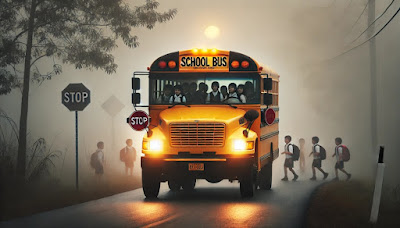Why Are School Buses Yellow? The Story Behind the Sunshine Hue
Ever wondered why school buses are almost universally painted yellow? It’s not just a random color choice; it's a decision rooted in safety, visibility, and a bit of scientific reasoning. So, buckle up as we explore the fascinating story behind the yellow school bus color.
The Visibility Factor: A Scientific Perspective
The primary reason for the yellow hue is its
exceptional visibility. Our eyes are more sensitive to yellow in
peripheral vision than any other color. This means we can detect a yellow
object, like a school bus, more quickly and from a wider angle
compared to, say, a red or blue one.
- Peripheral
Vision: Our peripheral vision is crucial for spotting objects on the
sides of our visual field. Yellow stands out, grabbing our
attention even when we're not looking directly at it. This is a very
important safety feature.
- Day
and Night Visibility: Yellow remains highly visible in various
lighting conditions, from bright daylight to dusk and dawn. This is a
critical factor for school buses that operate during different
times of the day.
- Adverse
Weather Conditions: Even in fog, rain, or snow, yellow
maintains a higher degree of visibility compared to other colors.
This is crucial for school bus safety, as buses often
operate in these conditions.
National Standards and Regulations: A Unified Approach
In the United States, the color of school buses is
standardized as "National School Bus Glossy Yellow." This
standardization came about after a 1939 conference held at Columbia
University's Teachers College. Dr. Frank Cyr, known as the "father of the yellow
school bus," spearheaded this initiative.
- Standardization
for Safety: The primary goal was to create a uniform color that would
be easily recognizable across all states, ensuring children's safety.
- National
School Bus Glossy Yellow: This specific shade was chosen based on its visibility
and the psychological impact it has on drivers.
- Federal
Motor Vehicle Safety Standards: These standards mandate specific
requirements for school bus design and color, reinforcing
the importance of yellow for safety.
Psychological Impact: Grabbing Attention
Beyond pure visibility, the color yellow also
has a psychological impact. It's associated with caution and alertness.
- Caution
and Alertness: Yellow is often used in traffic signs and
warnings to grab attention and signal caution. This psychological
association helps drivers become more alert when they see a yellow
school bus.
- Contrast:
The yellow color provides a stark contrast against various
backgrounds, making the bus stand out in diverse environments.
Why Not Other Colors? Addressing the "Ifs and
Buts"
You might wonder, "Why not red, which is also
associated with danger?" or "Why not a brighter color like
orange?" Here's why yellow reigns supreme:
- Red's
Limitation: Red, while associated with danger, can blend into the
background, especially in low-light conditions. It also doesn't stand out
as well in peripheral vision.
- Orange's
Problem: While orange is also highly visible, it doesn't offer the
same degree of peripheral visibility as yellow.
- White's
Issue: White, though bright, can be easily obscured by snow or fog. It
also doesn't provide the same level of contrast as yellow.
- Other
Colors: Other colors like blue, green, or brown simply don't offer the
same combination of visibility and psychological impact.
The Evolution of School Bus Safety: Beyond Color
While the yellow color is a crucial safety feature,
school bus safety involves more than just paint.
- Flashing
Lights: School buses are equipped with flashing red and yellow
lights to alert drivers when children are boarding or exiting.
- Stop
Arms: The extendable stop arm signals drivers to stop when children
are crossing the street.
- Mirrors:
Multiple mirrors provide the driver with a wide view of the surroundings,
minimizing blind spots.
- Seat
Belts and Compartmentalization: Modern school buses are
designed with padded seats and high seat backs to protect children in case
of a collision. Some also include seat belts.
- Regular
Inspections: Regular maintenance and inspections ensure the bus
is in optimal condition.
- Trained
Drivers: School bus drivers undergo rigorous training to ensure
they can handle the responsibility of transporting children safely.
The Global Perspective: Yellow's Prevalence
While the "National School Bus Glossy Yellow"
is a U.S. standard, the use of yellow for school buses is
prevalent in many other countries.
- International
Recognition: The visibility and safety benefits of yellow
are universally recognized, leading to its widespread adoption.
- Adaptations:
Some countries may use slightly different shades of yellow or
incorporate other safety features, but the core principle of high visibility
remains consistent.
Conclusion: A Lasting Legacy of Safety
The yellow school bus is more than just a mode of
transportation; it's a symbol of safety and security. The decision to
paint school buses yellow was a deliberate and scientifically sound
choice, prioritizing the well-being of children. While technology and safety
features have evolved, the iconic yellow color remains a constant
reminder of the importance of protecting our youngest passengers.












0 Comments